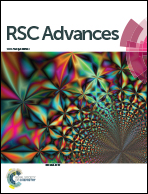N-doped mesoporous carbon nanosheets obtained by pyrolysis of a chitosan–melamine mixture for the oxygen reduction reaction in alkaline media†
Abstract
By simple thermal decomposition of low-cost precursors (chitosan, melamine) in an inert atmosphere, nitrogen-doped porous carbonaceous materials were prepared. The samples pyrolyzed at 700 °C are composed of mainly mesoporous nitrogen-doped carbon nanosheets and partially graphitized carbon. The nanosheets contain a disordered area due to the strain imposed by the presence of nitrogen and/or oxygen groups in their structure. Some portion of the material is comprised of clean well crystallized graphene sheets. They show an interlayer distance of about 0.359 nm. The average size of the visible well-crystallized carbon is 8 × 8 nm, covering ca. 4% of the samples flat projection. Further, these materials possess total specific areas up to ca. 285 m2 g−1, and exhibit efficient electrocatalytic activity (the onset potential of 0.735–0.761 V vs. RHE) for the oxygen reduction reaction (ORR) in alkaline media. Our results show that besides the total nitrogen content and the type of nitrogen group (pyridinic or graphitic), also the amount of carbon ‘kinks’ and/or surface roughness strongly influence the ORR activity.


 Please wait while we load your content...
Please wait while we load your content...